The Balinese, an oriental cat, was named after the graceful, traditional Balinese dancers that it resembled. It is really identical to its feline cousin, the Siamese, being a spontaneous mutation in a Siamese litter in the U.S. back in the 1950's, except it has a longer coat; it looks like a Himalayan cat but is not as fluffy.
The Balineses' former name was the 'Longhair Siamese' and it was first registered as a breed in the U.S. in 1963; it now comes in two distinct kinds; the apple-headed traditional version, similar to a Ragdoll cat, and the contemporary variety, with a much shorter coat and is virtually the same as a Siamese except for its plume like tail. There is also a relatively rare short-haired variant.
Because of its longer coat, the Balinese seems to have softer lines. Its long, straight head is in the shape of a tapering wedge, ideally, its skull is flat. It has a well-muscled, elegant, medium sized body, with light but strong structure; the males weigh from 12-16 pounds (lbs), and the females are a bit lighter at 8-12 pounds.
The Balinese's ears are often strikingly large, pointed and wider at the base. They have tear-drop shaped, medium-sized eyes, which are neither recessed nor protruding. Eye color comes in various tints of blue, in sapphire hues, the deeper the shade the better!
The nose is long and straight, a continuation of the forehead with no break; their muzzle is fine and wedge-shaped. Paws are usually dainty, small and oval. They have a long, thin, dense, clearly defined tail which tapers down to a fine point; the hairs, which are longest on the tail than other parts of the body, spread out like a feather.
The ermine coat of the Balinese is of medium length, fine and silky; they do not have a downy undercoat like many other breeds. The coat lies close to the body and may appear shorter than it is. They have points on the mask, ears, legs, feet; there is no ticking or white hairs in the points. Coat colors are same as the Siamese and include: seal, chocolate, lilac, and blue as well as less traditional colors such as cream and red. Coat patterns include styles such as the lynx (tabby) point and tortie point.
The Balinese's body is graceful, extended and svelte, with a long and slender neck and they have a majestic, regal bearing to them. Their body structure is a distinctive combination of fine bones and firm muscles. Shoulders and hips have the identical sleek lines of their tubular bodies. Hips are rarely wider than the shoulders, and they have a tight abdomen; their legs are long and slim, hind legs higher than the front. The male Balinese is usually somewhat larger than the female.
Balineses' do not usually require a lot of grooming, just an occasional brush or comb; routine nail cutting and good mouth hygiene is essential! Generally speaking, they are a fairly low maintenance cat.
Personality wise, they have an, outgoing, extroverted, extraordinarily loving and friendly temperament and bond closely with their owners. Making excellent pets, they enjoy fun and games and the indoor life and are cuddly and affectionate! Playfulness is a marked trait of this breed. Gregariousness prevails, similar to their Siamese relatives and they love to live in groups; they are quite vocal but have a softer voice than that of the Siamese cat.
The Balinese is highly intelligent, interactive, and can be quite demanding when it is seeking attention! They are easy-going cats and are not difficult to train; renowned mischief makers when they are bored, they love toys and will make anything and everything in to one! They will even play fetch, just like a dog would but won't tolerate mistreatment from others!
They need a good diet and plenty of exercise; generally speaking, they are very healthy cats and have few serious problems; sometimes furballs or hairballs can be an issue; lifespan is 10 -14 years.
This breed of cat is suitable for families with children and elderly people too. The Balinese gets along with other family members, as well as other pets, and have even been known to cosy up with the family dog on occasions!
For more informative cat articles, and for a large array of cat products and toys, Please visit: http://fatherspirit-catablog.blogspot.com/
Article Source: http://EzineArticles.com/?expert=David_Braybrooke
Friday, April 17, 2009
Cat Breed - Balinese
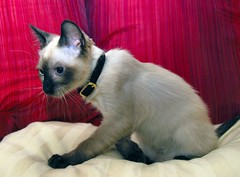 The Balinese, an oriental cat, was named after the graceful, traditional Balinese dancers that it resembled. It is really identical to its feline cousin, the Siamese, being a spontaneous mutation in a Siamese litter in the U.S. back in the 1950's, except it has a longer coat; it looks like a Himalayan cat but is not as fluffy.
The Balinese, an oriental cat, was named after the graceful, traditional Balinese dancers that it resembled. It is really identical to its feline cousin, the Siamese, being a spontaneous mutation in a Siamese litter in the U.S. back in the 1950's, except it has a longer coat; it looks like a Himalayan cat but is not as fluffy.The Balineses' former name was the 'Longhair Siamese' and it was first registered as a breed in the U.S. in 1963; it now comes in two distinct kinds; the apple-headed traditional version, similar to a Ragdoll cat, and the contemporary variety, with a much shorter coat and is virtually the same as a Siamese except for its plume like tail. There is also a relatively rare short-haired variant.
Because of its longer coat, the Balinese seems to have softer lines. Its long, straight head is in the shape of a tapering wedge, ideally, its skull is flat. It has a well-muscled, elegant, medium sized body, with light but strong structure; the males weigh from 12-16 pounds (lbs), and the females are a bit lighter at 8-12 pounds.
The Balinese's ears are often strikingly large, pointed and wider at the base. They have tear-drop shaped, medium-sized eyes, which are neither recessed nor protruding. Eye color comes in various tints of blue, in sapphire hues, the deeper the shade the better!
The nose is long and straight, a continuation of the forehead with no break; their muzzle is fine and wedge-shaped. Paws are usually dainty, small and oval. They have a long, thin, dense, clearly defined tail which tapers down to a fine point; the hairs, which are longest on the tail than other parts of the body, spread out like a feather.
The ermine coat of the Balinese is of medium length, fine and silky; they do not have a downy undercoat like many other breeds. The coat lies close to the body and may appear shorter than it is. They have points on the mask, ears, legs, feet; there is no ticking or white hairs in the points. Coat colors are same as the Siamese and include: seal, chocolate, lilac, and blue as well as less traditional colors such as cream and red. Coat patterns include styles such as the lynx (tabby) point and tortie point.
The Balinese's body is graceful, extended and svelte, with a long and slender neck and they have a majestic, regal bearing to them. Their body structure is a distinctive combination of fine bones and firm muscles. Shoulders and hips have the identical sleek lines of their tubular bodies. Hips are rarely wider than the shoulders, and they have a tight abdomen; their legs are long and slim, hind legs higher than the front. The male Balinese is usually somewhat larger than the female.
Balineses' do not usually require a lot of grooming, just an occasional brush or comb; routine nail cutting and good mouth hygiene is essential! Generally speaking, they are a fairly low maintenance cat.
Personality wise, they have an, outgoing, extroverted, extraordinarily loving and friendly temperament and bond closely with their owners. Making excellent pets, they enjoy fun and games and the indoor life and are cuddly and affectionate! Playfulness is a marked trait of this breed. Gregariousness prevails, similar to their Siamese relatives and they love to live in groups; they are quite vocal but have a softer voice than that of the Siamese cat.
The Balinese is highly intelligent, interactive, and can be quite demanding when it is seeking attention! They are easy-going cats and are not difficult to train; renowned mischief makers when they are bored, they love toys and will make anything and everything in to one! They will even play fetch, just like a dog would but won't tolerate mistreatment from others!
They need a good diet and plenty of exercise; generally speaking, they are very healthy cats and have few serious problems; sometimes furballs or hairballs can be an issue; lifespan is 10 -14 years.
This breed of cat is suitable for families with children and elderly people too. The Balinese gets along with other family members, as well as other pets, and have even been known to cosy up with the family dog on occasions!
For more informative cat articles, and for a large array of cat products and toys, Please visit: http://fatherspirit-catablog.blogspot.com/
Article Source: http://EzineArticles.com/?expert=David_Braybrooke
Labels:
Balinese
Thursday, April 16, 2009
Balinese Cat
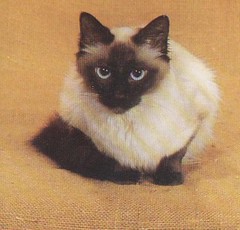 Balinese cat is a long-haired feline breed of oriental origin that is similar to the Siamese. It has the same traits and appearance as the Siamese apart from its flowing long hair. The cats were recognized as early as the initial decades of the twentieth century, in sporadic mutations of Siamese litters. However, it was not until 1950's when its beauty was truly appreciated and development of the breed started in earnest. The name 'Balinese' was given as a depiction of its grace, akin to that of exotic Balinese dancers.
Balinese cat is a long-haired feline breed of oriental origin that is similar to the Siamese. It has the same traits and appearance as the Siamese apart from its flowing long hair. The cats were recognized as early as the initial decades of the twentieth century, in sporadic mutations of Siamese litters. However, it was not until 1950's when its beauty was truly appreciated and development of the breed started in earnest. The name 'Balinese' was given as a depiction of its grace, akin to that of exotic Balinese dancers.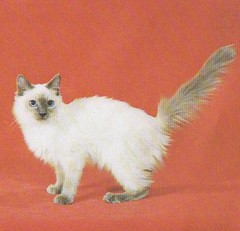 Over the years two variants of the cat have emerged. One is the 'traditional' Balinese with semi-long hair on whole of its body. Other is the 'contemporary' Balinese that has short hair on its body apart from its fluffy tail that has long hair. Both types have the same markings as Siamese cats, their only distinction being their ermine coat. Body is slim, long and muscular. Head is wedge shaped with sapphire eyes somewhat slanted in accordance. Recognized colors are the traditional Siamese blue, chocolate, lilac and seal. Other colors such as red and cream also occur, though such cats are often characterized as Javanese rather than the Balinese.
Over the years two variants of the cat have emerged. One is the 'traditional' Balinese with semi-long hair on whole of its body. Other is the 'contemporary' Balinese that has short hair on its body apart from its fluffy tail that has long hair. Both types have the same markings as Siamese cats, their only distinction being their ermine coat. Body is slim, long and muscular. Head is wedge shaped with sapphire eyes somewhat slanted in accordance. Recognized colors are the traditional Siamese blue, chocolate, lilac and seal. Other colors such as red and cream also occur, though such cats are often characterized as Javanese rather than the Balinese.The silky fur and aristocratic appearance makes the Balinese a sought after breed of felines. They are often considered to be the most intelligent of the longhaired cats. This alongside their single coat that does not get matted nor shed or require constant grooming means they are quite well suited to be the ideal house cat.
Despite their longish hair, the Balinese have a robust physical appearance and are sleek and attractive. Being quite active and playful, they require constant love and attention for their continual intellectual stimulation. At times may gain weight owing to lack of regular exercise. They are on the whole very good pets and companions.
The author is a blogger about cats and an expert on Balinese cats.
Article Source: http://EzineArticles.com/?expert=Omer_Ashraf
Labels:
Balinese
Monday, April 13, 2009
Information Regarding the Singapura Cat
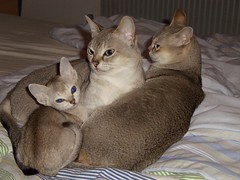 A shorthair feline, Singapura is said to have originated from Singapore. It is thought to have lived there for many years with locals reporting their sightings to go back as far as three centuries. However, it is not the commonest cat in the alleys of Singapore, and is often referred to as the drain or river cat owing to its habit of staying around water bodies in summer months. The cat was imported to United States in nineteen seventies and given championship status in early eighties. There is some controversy regarding the origin of Singapura with some arguing that it is not a natural cat and was artificially bred from Burmese and other cats, particularly with the recent emergence of reports that the genetic makeup of Singapura and Burmese is in fact quite similar. Nevertheless the felid is still recognized as a unique registered breed in most cat fancies across the world.
A shorthair feline, Singapura is said to have originated from Singapore. It is thought to have lived there for many years with locals reporting their sightings to go back as far as three centuries. However, it is not the commonest cat in the alleys of Singapore, and is often referred to as the drain or river cat owing to its habit of staying around water bodies in summer months. The cat was imported to United States in nineteen seventies and given championship status in early eighties. There is some controversy regarding the origin of Singapura with some arguing that it is not a natural cat and was artificially bred from Burmese and other cats, particularly with the recent emergence of reports that the genetic makeup of Singapura and Burmese is in fact quite similar. Nevertheless the felid is still recognized as a unique registered breed in most cat fancies across the world.A relatively tiny animal, Singapura is a small but muscular cat. Both genders weigh in the range of five to seven pounds. General appearance is that of a dainty and somewhat unique feline. Coat is short and in a ticked tabby pattern. Only a sepia brown coloration is seen that is quite similar to the coat of mountain lions. Head is rounded with big expressive eyes that occur in green, yellow or hazed color. Paws are small and tail is normal in length.
Singapuras have all emerged from only a handful of ancestors and therefore they don't have a lot of genetic diversity amongst them. There have been few hereditary illnesses in some of their lines. Since outcrossing is not commonly practiced for these cats, breeders are trying to locate specimens in other parts of the world for induction into the gene pool to add variety.
Singapuras are affectionate cats that spend most of their time playing or staying perched on high places, surveying everything. They follow their humans around everywhere and prefer to be involved in all of their activities. Singapuras are social cats that go along well with everybody, including children, pets and even strangers. They are very gentle and communicate in a soft meow. Sensible animals they don't damage furniture or household items despite their curious and playful nature. Singapuras take time to mature and often it is around two years before they bloom fully into bundles of love and beauty.
The author is a blogger about cats and an expert on Singapura cat.
Article Source: http://EzineArticles.com/?expert=Omer_Ashraf
Labels:
Singapura
Friday, April 10, 2009
Birman - The Facts Every Owner Of This Cat Breed Should Know
 The history of the Birman cat is steeped in mystery. According to legend, the people of Asia built a temple to worship a golden goddess with sapphire-blue eyes. A priest often knelt in meditation with a white temple cat. One night the temple was attacked at the priest killed. As the priest died, the cat placed his feet upon the priest and faced the golden goddess. As he did, the hairs of his white body turned golden, and his yellow eyes to sapphire-blue, his four white legs turned brown, but where his paws rested, they remained white. Where this legend ends, history begins.
The history of the Birman cat is steeped in mystery. According to legend, the people of Asia built a temple to worship a golden goddess with sapphire-blue eyes. A priest often knelt in meditation with a white temple cat. One night the temple was attacked at the priest killed. As the priest died, the cat placed his feet upon the priest and faced the golden goddess. As he did, the hairs of his white body turned golden, and his yellow eyes to sapphire-blue, his four white legs turned brown, but where his paws rested, they remained white. Where this legend ends, history begins.The temple was raided at the beginning of the 20th century. Two westerners, Auguste Pavie and Major Gordon Russell, came to the aid of the priests. As a gesture of gratitude the priests later sent the two men a pair of Birman. The male cat did not survive the trip but the female, who was pregnant, did. The Birman is an average size cat (males generally ranging from eight to twelve pounds, females seven to nine pounds).
Birman - The Facts Every Owner Of This Cat Breed Should Know
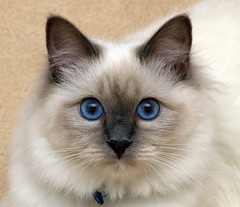 Birmans have a medium length coat that requires very little grooming. The coats are usually a light color on the face and darker over the rest of the coat, with golden shades being the most popular. Their eyes are always blue and their paws are white. Birman coats are long but not very dense, so they are not prone to matting. As the third most popular longhaired cat, Birmans are good pets. They tend to enjoy the company of their human families.
Birmans have a medium length coat that requires very little grooming. The coats are usually a light color on the face and darker over the rest of the coat, with golden shades being the most popular. Their eyes are always blue and their paws are white. Birman coats are long but not very dense, so they are not prone to matting. As the third most popular longhaired cat, Birmans are good pets. They tend to enjoy the company of their human families.Birmans are described as 'soft spoken,' but social and friendly. Birmans are considered sweet and because of this, they are able to adapt well to changes and adore their family. They tend to be a healthy breed; Birmans are generally free from any medical concerns, but some are sensitive to anesthetics. Birmans also require relatively little training and will learn to use the litter box on their own.
There is a website that has great information on Birmans and most other breeds of cats. It has details that pertain to a cat breeds health, grooming, living conditions, best food choices and more, the website is called: Dog And Cat Facts, and can be found at this url:
http://www.dogandcatfacts.com
By Robert W. Benjamin
Copyright © 2007
You may publish this article in your ezine, newsletter, or on your web site as long as it is reprinted in its entirety and without modification except for formatting needs or grammar corrections.
Robert W. Benjamin has been in the software business on the internet for over 5 years, and has been producing low-cost software for the past 25+ years. He first released products on the AMIGA and C64 computer systems in the late 1970's-80's.
Stop The Fleas
http://www.stopthefleas.com
Article Source: http://EzineArticles.com/?expert=Robert_Benjamin
Labels:
Birman
Subscribe to:
Posts (Atom)